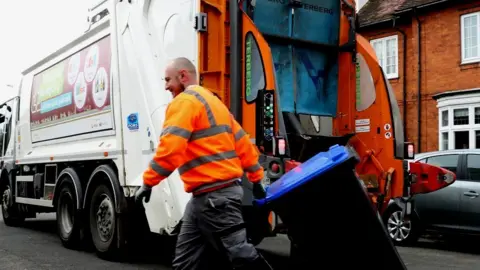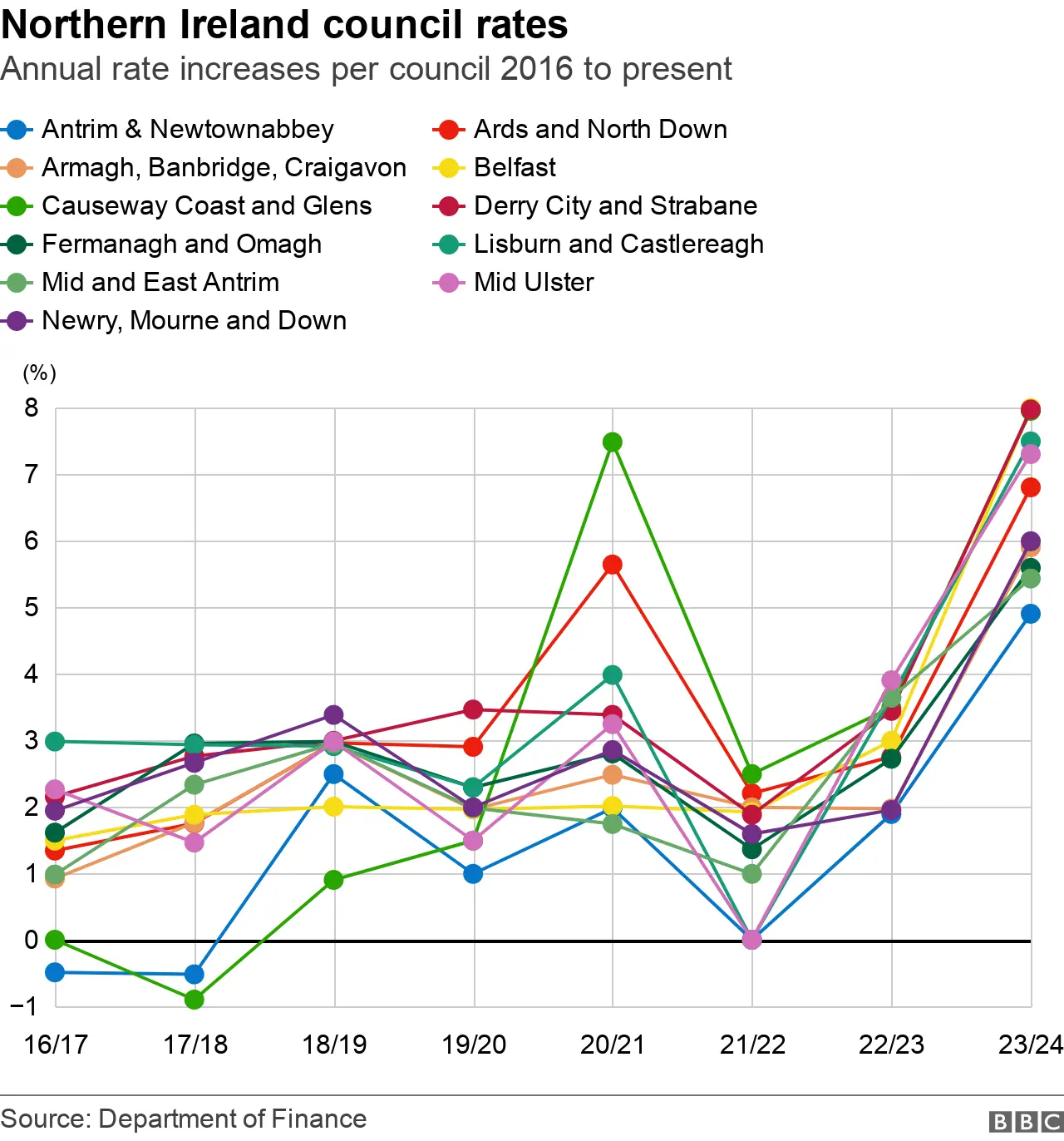NI rates: How much higher will your bill be?
 Getty Images
Getty ImagesHouseholds in Northern Ireland are facing a record rise in rates bills as councils attempt to balance their books.
All of Northern Ireland's 11 councils have agreed their highest rise since a reform of local government in 2015.
The biggest annual increase of 7.99% is in Belfast, where the council had never before risen rates by more than 3%.
The Northern Ireland Local Government Association (Nilga) said a significant rates rise was "unavoidable".
"Councils are acutely aware of the pressures on ratepayers at the moment during the cost-of-living crisis," said a Nilga spokesman.
"However councils are not immune from these financial pressures either.
"The current inflationary crisis has put a significant squeeze on the finances and resources across the local government sector in Northern Ireland."

Rates in Northern Ireland pay for public services and projects.
Bills are calculated on property value using what is known as the district rate and the regional rate. Councils set the district rate.
The regional rate is usually set by the Northern Ireland Assembly but, in the absence of a sitting assembly, the Northern Ireland Office will set the regional rate.
It is understood that rate will be struck ahead of bills being sent out in April.
The absence of an assembly, the Nilga spokesman said, "has further complicated the picture, with the cuts to the Rates Support Grant placing greater pressure on the least well-off council areas".
 Getty Images
Getty ImagesIn 2015 Northern Ireland's then 26 district councils were replaced by 11 larger councils.
In the years since only once - in 2020 in Causeway Coast and Glens - has any of the councils increased rates by more than 7% annually.
But this year rates will go up by more than 7% in five of the 11 local authority areas.
Only one council - Antrim and Newtownabbey - has agreed an annual percentage increase of less than 5%.
Below, BBC News NI examines the rates situation in each council area.

Antrim and Newtownabbey
Antrim and Newtownabbey Borough Council has agreed to increase its rates by 4.9%, the lowest increase across all of Northern Ireland's councils.
The rise in April is more than double the council area's previous annual increase of 2.49% in 2018.
Mayor Stephen Ross said this year's increase would equate to a weekly rise of less than 40p for the average household.
"Given the current cost-of-living crisis and difficult times we are all experiencing, I am satisfied the council has worked hard to maintain and deliver a low rates increase," he said.

Ards and North Down
The council agreed a rates rise of 6.8% - a figure that is twice as high as the annual increase in six of the past seven years.
Mayor Karen Douglas said the rate had been agreed at a time of mounting financial challenges including increases in inflation and energy costs.
"We face increased cost pressures of between £9-10m in the coming financial year," she said.
In agreeing the rate, she said the council needed to "strike the balance between agreeing a figure that allows us to deliver the services and investments residents want, while seeking to ensure the financial burden placed on our ratepayers is as low as possible".

Armagh, Banbridge and Craigavon
Until now, rates in the ABC Council area have never increased annually by more than 2.95%.
But from 1 April rates in the district will rise by 5.96%.
"Never in the history of council has elected members and council officers faced as sharp an increase in the cost of living," said Lord Mayor Paul Greenfield.
Inflation, energy costs and contractual salary obligations have "created a huge strain" on budgets, he added.

Belfast City
Belfast City Council has agreed to increase household rates by 7.99%.
Councillors had never previously agreed to an annual increase higher than 2.99%.
Emmett McDonough-Brown, chair of the council's Strategic Policy and Resources Committee, described the council's ability to keep rate increases below 3% for the last seven years as a "significant achievement".
However the Alliance Party councillor said no-one, including councils, was exempt from the effect of the cost-of-living crisis and the rising costs of energy and services.

Causeway Coast and Glens
Councillors have agreed an increase of 7.95% for householders from 1 April - a figure higher than the rise agreed in 2020 when the local authority announced it was £68.7m in debt.
Mayor Ivor Wallace said the rise was needed to combat "unprecedented" utility and energy costs.
He added: "The ongoing health crisis and uncertainty around central government funding has meant the organisation has been faced with almost £7.2m of additional financial pressures beyond our control."

Derry City and Strabane
Household rates in the north-west will increase by 7.97% after councillors agreed to a figure more than double any of its previous annual increases.
Independent councillor Paul Gallagher described the rise as "driving austerity on the people of this district who are facing great hardship".
The council also agreed to make cutbacks of over £3.5m, including voluntary severance, an increase in off-street car parking charges and reductions in street cleansing and grounds maintenance services.

Fermanagh and Omagh
Fermanagh and Omagh District Council voted for a 5.59% rise. It also has never previously agreed an annual increase of more than 3%.
The council's chief executive Alison McCullagh told councillors: "The Covid-19 pandemic, leading on to the current cost-of-living crisis, and the various pressures facing the wider economy, also impact on the council.
"This has probably been the most challenging year since the inception of this super-council and the two previous legacy councils."

Lisburn and Castlereagh
The council agreed a 7.94% increase from last year's rates for the district.
Its previous biggest annual rise was in 2020 when a increase of 3.98% was agreed.
"We have not taken the decision lightly to increase rates but the reality is we are responsible for vital services that must be delivered," said Ulster Unionist councillor Stuart Hughes.
"We are keenly aware of the financial pressures our ratepayers are facing."

Mid and East Antrim
Average bills will rise by £27.35 a year in Mid and East Antrim after a rates increase of 5.43% was agreed.
Rates have never increased by more than 3.7% since the council's formation in 2015.
"Our focus as always has remained on striking a rate that protects front-line services, is sustainable yet allows us to develop," said Mayor Noel Williams.
"However we fully recognise the difficult year that businesses and communities have had in relation to the cost-of-living crisis, to the rising energy prices and of course particularly as we come out of the pandemic."

Mid Ulster
Mid Ulster District Council has agreed to increase household rates by 7.3%.
Just two years ago it - along with Antrim and Newtownabbey, and Lisburn and Castlereagh councils - was able to freeze rates.
Sinn Féin councillor Cathal Mallaghan, who proposed the 7.3% rise, said it was due to the "cost of energy, labour shortages and interest rates".
He also said the "decision two years ago to strike a 0% increase in the rate is still something we are paying for now".

Newry, Mourne and Down
In the Newry, Mourne and Down district, householders face a rates hike of 5.99%, double the annual increase in four of the last seven years.
Council chairman Michael Savage said this year's rates increase reflected the "difficult situation" the authority was facing.
Energy bills and increased staff wages were contributing factors, he added.
"Overall we are facing increased costs of £11m in the coming financial year," he said.

